Avocado Uncovered
Inside California's $320 Million Avocado Industry
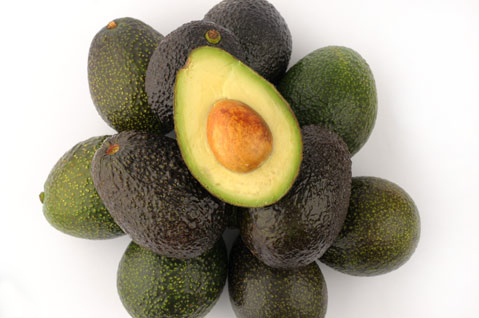
The avocado is a fruit. The Hass variety, with pebbly black skin and a yellow-green flesh, dominates the commercial market, but other varieties — like the Bacon, with bright, smooth skin and paler flesh, or the Fuerte, with leathery green skin — occasionally find their way to California’s farmers’ markets. In Santa Barbara, “avocado” also refers as much to the fruit as to the tree, Persea americana, which is evergreen, alternate bearing (so substantial harvests come every other year), and, like the banana tree, climacteric, meaning that the fruit matures on the tree but only ripens once you pick it.
That and a good recipe for guacamole is usually where the colloquial understanding of the avocado ends, which means you might not know that “avocado” is rooted in the Aztec word “ahuacatl,” which translates to “testicle,” so named because the ancient Mexican peoples believed in the fruit’s sexual powers, thinking it able to induce erotic prowess and enhance fertility to the point that virgins were kept indoors during harvest. The Spanish conquistadors — who came, conquered, and corrupted the Aztec term to “aguacate” — noticed a fluid secreting from the pits, and used the almond-smelling fluid to inscribe official documents in its indelible red ink. The fruit soon sailed back to the Old World, and eventually found its way to the West Indies and into George Washington’s mouth in 1751. The first recorded use of the English word “avocado” was in Jamaica in 1696, but it wasn’t until a 1915 meeting at the Hotel Alexandria in Los Angeles that a group of growers hotly debated what the official English name would be, and then informed the dictionaries of a new entry: “avocado.”
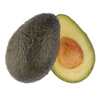
No matter what you call it, though, the oily fruit caught on and today is enjoyed in an endless collection of manifestations. In Brazil, avocados are pureed and frozen into ice cream and sherbets. In the Philippines, a chilled flurry of mashed avocados, cream, and sugar is a favorite treat on hot afternoons. In Guatemala, restaurants serve a ripe avocado alongside salt and pepper for customers to eat in spoonfuls with their hot meals. In Ethiopia, they’re mixed with an herb-tinged purple soft drink and topped with a twist of lemon. And in America, on Super Bowl Sunday, 50 million pounds of guacamole are consumed, which some say is enough to cover a football field almost 30 feet deep.
But the commercialization of the avocado — at least in the United States — is rooted in Santa Barbara. Here, in 1871, Judge R.B. Ord carried three saplings back from Mexico, nurtured them in his garden near the corner of De La Vina and Canon Perdido Streets, and bestowed their fruit upon the young city, making Santa Barbara the country’s first avocado-eating town and — thanks to Kinton Stevens planting 120 trees in Montecito in 1895 — the site of its first commercial avocado orchard. From here, the avocado plantings stretched down — and even a bit up —
the California coastline, where now 6,000 farmers grow more than 90 percent of the United States’ entire crop, from Monterey County to the Mexican border.
Today, the annual harvest makes avocados a $320-million industry in the Golden State alone. There are challenges, of course, from escalating costs of water and other farming necessities to the economic threats from international markets. But demand for the fruit is unbounded, even when it takes $10 of avocados just to make one proper bowl of guacamole. As one Carpinteria avocado farmer explained, “The avocado is the envy of the produce world. I mean, no other agricultural commodity has a consumption rate that rises at 15 percent per annum.”
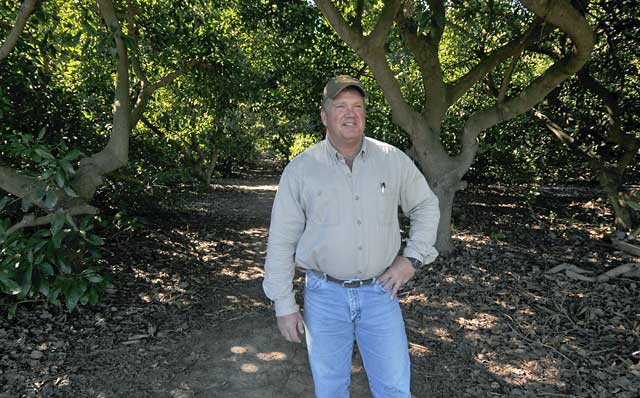
Getting a Handle on Harvest
“If you want to know about avocados, you gotta talk to Rick Shade,” one farmer told me early on in my reporting. Shade owns some of his own trees, but he’s primarily a farm manager, in charge of 600 acres of avocado and citrus trees around Santa Barbara County.
When we first met in his Carpinteria office, Shade made a quick disclaimer. “Just to warn you, I’m already overexposed in the media,” he said, gesturing toward the framed newspaper clips behind him, which came from his time as chairman of the California Avocado Commission (CAC) when a state audit uncovered $1.5 million of dubious spending. Shade wasn’t involved in the scandal, but when the then-president skipped town, he found himself the de facto face of the organization, answering reporters’ questions and taking a leadership role during the crisis.
This past fall, Shade took me to a couple of picking days during harvest. The avocado has a finicky reproductive process. Its unique flower is hermaphroditic — opening as female in the morning, turning male in the afternoon — homely in appearance, and lackluster in scent, leaving the only hope for attracting bees to be a massive bloom, usually with one million flowers per tree. Some studies suggest that the odds of a fruit actually setting are 1 out of 2,000 blooms. Complicating matters more is that avocado trees are alternate bearing, so a bumper crop one year — which exhausts most of the tree’s carbohydrates — translates to a weak harvest the following year. Last year was definitely an “on” year, but that was to be expected, given the previous year’s frost and freeze, the heavy, nurturing rains of January, and the low stress of a cool summer. But nobody expected the incredible bounty of the yield: a whopping 500 million pounds of fruit statewide, the fourth biggest on record.
As we drove through the groves, Shade proudly proclaimed that he’s a third-generation avocado grower and fifth-generation California farmer, that he likes to restore antique tractors in his spare time, and that he has three kids, now adults, with his wife, Trish, who runs the office of Shade Farm Management. Upon parking at a half-finished palatial estate, with a plot of avocado saplings laid down before it, Shade explained that the owners are foodies with high-paying jobs and young children who love the idea of being surrounded by avocados.
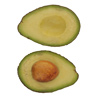
As farm managers like Shade can attest, this Arcadian fantasy of enjoying the idyllic pastoral existence is not too far removed from the reality of avocado life: The majority of California’s 6,000 growers run small, family-owned operations, with an average grove size of 10 acres. While absentee ownership has been a facet of farming since the dawn of agriculture, the avocado grove holds particular appeal for farming neophytes who own the land but never work it: The trees are always leafy green, the groves are relatively low-maintenance, and the fruit is talismanically Californian. And there are plenty of farm managers like Shade to run the operation, from advising on how to optimize tax breaks to hiring the crew to pick the fruit.
We eventually come upon a group of pickers working a hillside grove, where trees are planted closer than they were in the old days in order to squeeze more fruit out of each acre. Avocado trees grow well on grades — water trickles down, maximizing the dispersal, and cool air drains to the bottom, helping to stave away frost — but it makes harvesting difficult. To pick an avocado off a tree on an incline, the ladder can only go one place. The picker inevitably hovers above a downward slant, body saddled by a sack of avos weighing nearly 100 pounds, maneuvering a pole to clip and catch high fruit. “Burly men,” reflected Shade, “that’s all I can say.”
As we walked through a more old-school vision of avocado growing — sky-scraping, stately trees grown 15 or so feet apart — the August heat suddenly cooled into a snap. High overhead was a canopy overloaded with fruit, belonging to a tree possibly more than 50 feet tall, gnarled and wild, as if un-pruned for five decades. Shade admired the shady scene in silence and then, in a moment of unguarded wistfulness, said, “It’s like a cathedral in here.”
Minutes later, he tells me that the tree will soon be torn down, because the labor costs to harvest a tree that size aren’t worth the returns. It’s a stark reminder that, at the end of the day, even the most nostalgic farmers must first be businessmen: Economic survival will always trump sentiment.
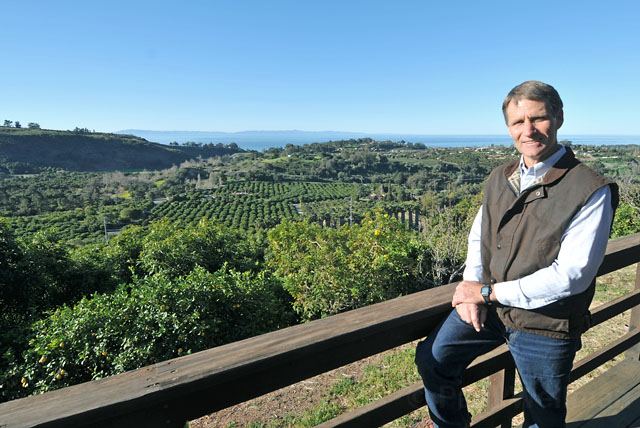
Going Global
Despite the outward appearance of paradise, things are getting harder for the California avocado grower. There’s an ever-expanding volume of foreign fruit from Mexico, Chile, and Peru, all of which grow avocados with much cheaper water and land. That makes prices for California fruit drop at the same time that growing costs are rising, with land prices steadily climbing even in a recession and water becoming shatteringly expensive, tenuously available, and increasingly saline. Altogether, the state’s overall avocado acreage is actually shrinking, according to industry statistics.
Since those first trees were planted in Santa Barbara back in the 1870s, California farmers had pretty much locked down the American market. That changed in 1994, when the federal government lifted an 80-year-old ban on the economically fearsome and allegedly pest-ridden Mexican avocado. But to the farmers’ surprise, the imports actually helped the California market because Mexico could supply fruit in the state’s off-season, which steadied year-round demand.
“Mexico was stabilizing,” Scott Van Der Kar told me while standing in his family’s grove, explaining that people in Mexico consume a lot of the produce grown there. “But Chile has been destabilizing.” That’s because the skinny South American country is almost entirely an export market that, according to the Chilean Avocado Importers Association, shipped 300 million pounds to the United States last season alone. Such a total equals more than half of what California picked in 2010, the state’s fourth largest haul on record, so it’s easy to see how international competition is changing the avocado landscape.
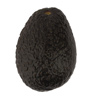
The Van Der Kars didn’t come to the South Coast until the late 1960s, when the big chunks of land had already been claimed, so their 150 acres of orchards are scattered throughout Carpinteria. The grove where we met was one of the loveliest examples around, with hillside plantings alternating in blocks of avocado and lemon, every tree robust and vased, sloping down to an unbounded view of the city and ocean. As I admired the setting, Van Der Kar explained that it’s his 16th year on the board of directors at Calavo Growers, Inc., the American industry’s biggest packinghouse. In 2001, it changed from being a nonprofit cooperative to a publicly traded, for-profit company — a decision not met with universal approval in the avocado community. Van Der Kar explained that having a not-for-profit co-op was a gift to the market due to high volume being pushed, but “there wasn’t incentive from the business standpoint to realize its production potential. To go beyond nonprofit, you need the spirit of a for-profit company.”
Before leaving his ocean view plot, I asked Van Der Kar about the future of the California avocado farm, and what could be done to ensure its long-term survival. “You can never stop expanding,” he replied. “You need to always be growing.” Even as production per acre improves, his becomes an increasingly difficult stance to take in California, a state where water supplies dwindle, land prices escalate, and the plight of the small farmer darkens in the shadows of new producers overseas.
Marketing the Market
There was a famous commercial in the 1980s in which the luxuriously blonde actress Angie Dickinson donned gold stilettos and a white leotard to endorse the avocado’s vitamin content and, at the end of a leggy, voyeuristic pan, drawled, “Would this body lie to you?”
Designed to counteract a flood of bad press about the fruit’s fat content, the advertisement was the work of the California Avocado Commission, which has been upholding the premium of the Golden State’s brand for decades. Without the CAC’s efforts, it’s unclear whether any California farmer would survive the onslaught of competition from other countries, a fact considered by almost every one of the 30 farmers I spoke with for this story from across Southern California.
Evolved from the growers’ association that began meeting in 1915 but not officially incorporated until 1978, the CAC’s objective is to maximize grower returns through promotion, marketing, and research. By state law, growers pay a mandatory assessment to the CAC, this past year rolling in at $14 million. With that, the CAC forges the avocado’s consumer identity, although it’s strange that it does so in an office housed in one of Irvine’s nondescript technology parks, a place that seems almost identity-less.
That’s where, one day last August, I met the CAC’s unswerving vice president of marketing, Jan DeLyser, whose every word boils down to one basic notion: the vital need to use the formative power of advertising to effectively market the California avocado. “It used to be that doctors would tell patients not to eat avocados,” she explained of the Angie Dickinson ad, a strategy that eventually paid off. “Consumers in 1996 — about two-thirds of them said that barriers to purchase were the healthfulness of the avocado. Now, about three-quarters of them say that the reason to purchase is the healthfulness.”

DeLyser is often credited for the CAC’s ongoing “Hand Grown in California” campaign, which depicts an open avocado suspended in front of a farmland backdrop, nostalgically rendered with muted colors, indigo shadows, and a straw-colored sky. It’s purist and sentimental, evoking the fruit-crate art of the early 20th century. She explained that the campaign now includes a “California Growers” feature, in which portraits of avocado farmers and accompanying stories about their meticulous craftsmanship and generational pedigree now look up at you from picture ads on your grocery cart. The campaign even has a grower reminiscing on the radio about how the first food he fed his children was guacamole, so it’s clear that the whole effort is about giving the avocado a narrative. Where before there was just food, now there is a face and a place to the fruit. It’s a means of branding localism, and the market shows that it works: Consumers will pay 13 percent more for California avocados during their season of peak availability, which is 15 cents extra per pound.
DeLyser speaks with an unwavering faith in the efficacy of the word “California” as a brand, which reflects the CAC’s goal since inception, to push the avocado as the Golden State’s official lifestyle fruit — to buy an avocado, the message goes, is to buy the California aesthetic. But although the fruit thrives in the mountains that overlook the beaches of Southern California — indeed, more than 60 percent of the fruit comes from San Diego County these days — the push is strategically more toward the middle of our massive state.
“We’ve been appealing to the Napa type over the Hollywood type,” DeLyser explained, proof that the fruit’s advertising life cycle is always shifting, that the avocado’s California image is no longer Angie Dickinson in a leotard. “We’re not showing people running around in bathing suits.”
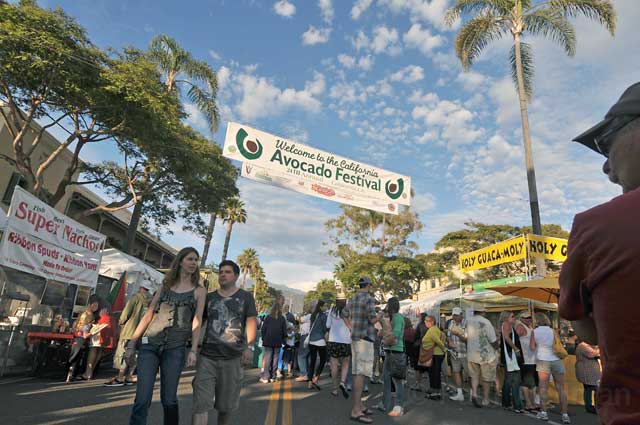
Fantasy Versus Farmer?
Every October in downtown Carpinteria, the seaside town of 14,000 or so people suddenly inflates with more than 100,000 souls when the annual California Avocado Festival invades for three days. It’s the classic combination of Carp’s two main industries — avos and tourism — and serves to celebrate the community while boosting the economy. But according to some farmers I spoke with, the fest has been brewing a bit of unrest in recent years because much of the business is being contracted outside of the community, with MillerCoors beers and Cold Stone ice creams pushing aside last year’s suds from Island Brewing Company and flavors from McConnell’s. As one farmer put it, “It’s a City of Commerce boondoggle.”
I visited the 24th annual Avo Fest last fall, and found guacamole — obviously, omnipresent — as well as applications such as avocado teacake, avocado agua fresca, and avocado ice cream (though the deep-fried avocado was reportedly missing that year). At the front of the festival was a big white expo tent where autodidacts could seek information from industry pros like Rick Shade, who stood behind the CAC’s table, which was furnished with free swag: magnets, bumper stickers, avo scoopers, recipes. There were middle-school sketches of “Halloween Avocado” and “Ballerina Avocado,” and, away from the tent, a man was wearing an inflatable avocado suit accessorized with aviator shades and a stuck-out tongue. There were bouncy houses for the kids, commercial vendors of all kinds, a gymnastics team performance of an avocado-themed adaptation of the Broadway musical Wicked, and a big Nintendo photo station in the middle of Linden Avenue. Altogether, Avo Fest is very family-oriented and, like any other food fest, only partially about the fruit in question.
“It seems less local than it used to be,” a Carpinterian named Austin said while standing in front of Sunburst Printers, a silk screening company that sold unofficial festival tees, as the official Avo Fest T-shirt was designed by a man in Los Angeles. That led some to ask, if the purview of the festival is to benefit the Carpinteria community, then why contract so much business outside of it? The value of avocados in and of themselves is discrete, it seems, but their value as they relate to the people and places that produce them is infinite.
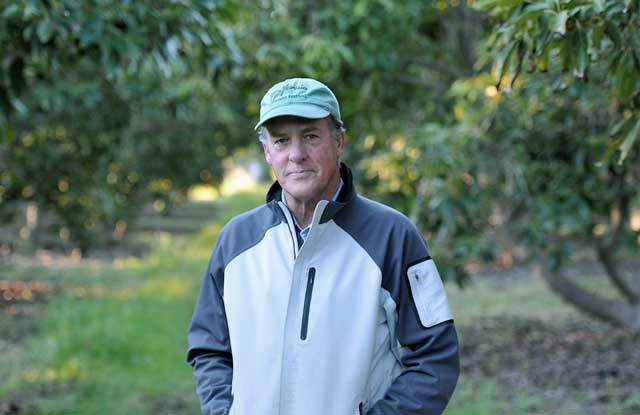
Nothing hammered that home more than remembering my visit just two hours earlier with farm manager Carl Stucky, who constructs nuanced explanations and pocket histories without pause, delivering them in a cadence that is half cowboy, half surfer. After talking a bit about why the avocado is so expensive — he chalked it up partly to produce shrink, whereby some of the fruit delivered by growers gets thrown out by the retailers because it’s not pristine enough for the increasingly discerning consumer — I asked him if the avocado will ever diversify like the apple, with multiple, seasonal varietals in the market, and whether the Hass will ever be dethroned.
As an answer, Stucky ended up talking about a Mexican varietal, which I’d never heard of, with ruffled edges on the leaves and a flavor of anise in the flesh. He wandered off, rustled some branches, and returned with two leaves, one a Hass for comparison, the other the Mexicola. He instructed me to try one, then the other. “See?” he asked. “You can tell what the fruit will taste like by the leaf.”
I had been from farm to fest and back. The divide between the consumer image of avocados and the lives of growers appears unbridgeable to me, despite the CAC’s “Hand Grown in California” efforts and the narrative localism it’s meant to evoke. But maybe we, as Santa Barbarans, should charge ourselves with considering the avocado a bit more deeply. Where do we stand amid all the marketing and the mystique? What do we taste when we eat according to our civic, avocado-loving compulsion to connect farm to table?
EDITOR’S NOTE: Some factual corrections have been inserted since the original publishing of this article.



